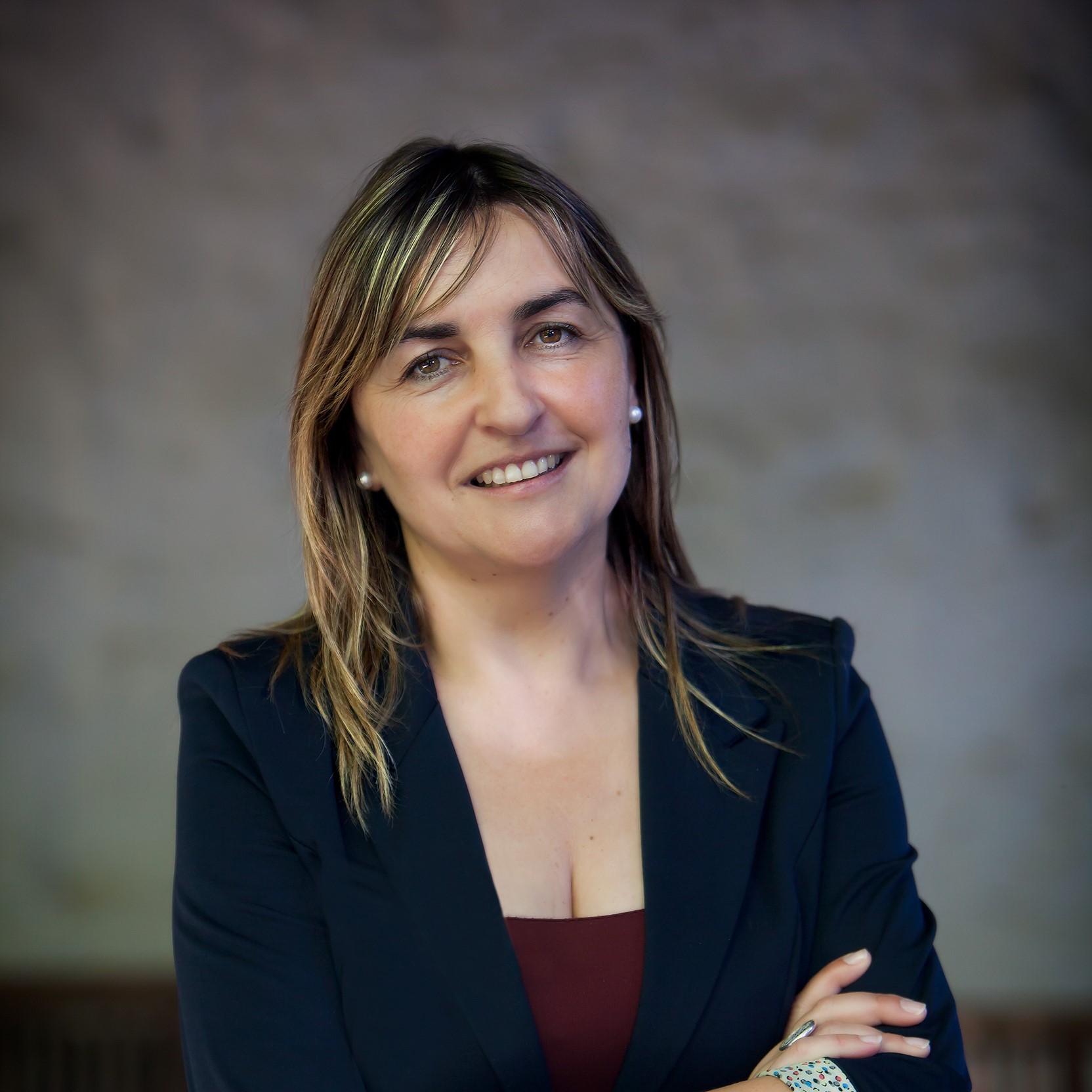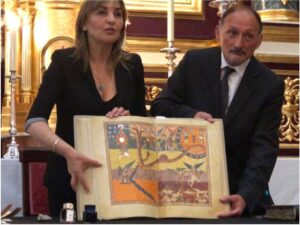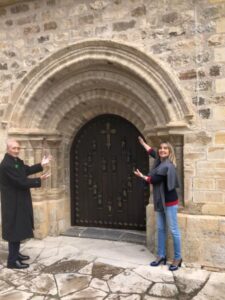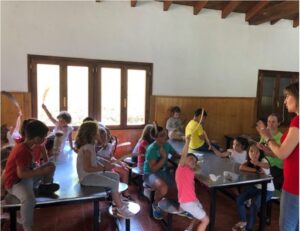
Pilar Bahamonde has been a member of FRH since 2012 and Council Member since 2016. In October 2020, she was elected as the FRH council president. She is the director of the Centre of Studies of Liébana, an institution belonging to the Regional Education, Culture and Sports Society of the Government of Cantabria, and has vast experience in all tasks connected with cultural tourism in rural areas. She is specifically dedicated to the preservation and promotion of tangible and intangible religious heritage, focusing on pilgrimage.
In honour of FRH’s 10th year anniversary, we’ve conducted an interview with Pilar to hear her thoughts on FRH’s achievements, the importance of its mission, and what she sees for the future of our network.

1. Why did you join FRH?
Well, I had to! There was no other option for me…
Back in 2005, when I first saw the restoration project of the old parish church in the small town of Potes, in the mountainous region of Picos de Europa. I took pictures of the architecture and loved the results of the craftsmen.
Later I got to work in it. I observed the transformation of the church into an inclusive splendorous centre for arts, education and culture, serving the local community and its visitors. I was amazed. Since then I have always been concerned with those buildings in a bad state and those imbricated in the empty towns and villages of my region of Spain. And you know what? I found no answers… at least none good enough for me; they were either too vague or too drastic and accepting. There was a feeling of resignation, I would say. That was not my cup of tea, certainly not…
In a congress at Barcelona University, I got to know about the organization and became curious. To be honest, it was later at the biennial conference that took place in Venice that FRH made an impact on me. It was a real eye-opener. Everybody was inspiring, the leaders, members, institutions, and speakers from all corners of Europe. I found the exchange of knowledge, good practices, and debates to be crucial for the preservation of the religious cultural heritage of Europe.
I had to join. Cantabria had to join. So, before I knew it, I was already transferring all my impressions into a report to the General Directorate of Culture during the flight back home. It has been a long way since those days, and now we are celebrating the 10th anniversary.
2. What does religious heritage mean to you?

Identity, belonging, cultural diversity, and spirituality: our own spirituality and that of others. It also means art, effort, endeavours, long term thinking, solidarity. Religious heritage is the biggest museum of Europe, and its buildings are markers of it connected by routes and paths and lanes which were the highways of their time. Cathedrals, synagogues, mosques, chapels, hermitages are real palimpsests. They hold layers upon layers of history and art. As Klimt’s inner circle would say “to each time its art and to each art its freedom”
Whenever a heritage site is destroyed or damaged we all lose a piece of our identity. I didn’t need to be French to suffer immensely after the tragedy of Notre Damme or the destruction of the Organ of Nantes, which will be silent forever… did you? Of course not. Because this is a shared feeling with millions of citizens, not only in Europe but in the whole world…
Whenever I travel throughout Europe I might not recognize different institutional buildings but the ones I certainly do recognise are the cathedrals. And when inside, I can experience a sense of time slowing down along with a feeling of welcome. I can sit and contemplate a spiritual space created by our ancestors with their limited tools, vast knowledge and masterful skills. At that moment, I am immediately reminded of the words of Robert Schumann, one of the founding fathers of Europe, who said in a letter in 1947 “In any country of Europe, I enter a Cathedral and I feel European”. I can´t help feeling passionate about it… This feeling is also shared in a synagogue or a mosque…
Please, allow me to share how I see them. To me, they are proud standing examples of the crafts and knowledge of so many generations of craftsmen, architects, stonemasons, artists, musicians and painters. Europeans build their cathedrals and religious buildings stone by stone. And pilgrimage is the invisible thread that connects us Europeans like a web from north to south, east to west…
3. What is one of the biggest challenges facing religious heritage?
I would need a whole afternoon to reflect upon this… However, I would reduce it to 3 main aspects: Indifference, lack of knowledge and time. This is a very dangerous combination, and catastrophes or vandalism can easily do the rest. We are running out of time. Some of the skill sets and professions will soon disappear if we don’t act rapidly. And nobody will have the knowledge to restore these amazing pieces of art and transmit them to future generations. We need to think of a sustainable system. We need to learn from the past to make sure we secure the future of Europe. Religious buildings, synagogues, mosques, and churches are a part of the social, cultural and artistic landscape of Europe. If they disappeared, how would we explain this to the new generations?
4. What is one of the best ways we can protect religious heritage?
 Raising awareness…and separating religion from religious heritage. Only then will we look at this shared heritage in the same way we look at civil heritage. We cannot love what we don’t know. These words are not mine, they are Saint Augustine’s from 17 centuries ago. We need to raise awareness in youth, especially, by not telling them what to think but by inviting them to think, reflect and participate in the search for possibilities and solutions. We need to show them that this is their cultural heritage too. And we need to start from an early age.
Raising awareness…and separating religion from religious heritage. Only then will we look at this shared heritage in the same way we look at civil heritage. We cannot love what we don’t know. These words are not mine, they are Saint Augustine’s from 17 centuries ago. We need to raise awareness in youth, especially, by not telling them what to think but by inviting them to think, reflect and participate in the search for possibilities and solutions. We need to show them that this is their cultural heritage too. And we need to start from an early age.
Very soon the secularization of Europe will create a gap of knowledge in terms of Religious cultural heritage that will be immense. (buildings, artefacts, clothing, vocabulary, symbols, etc) Let me give you an example. Europe stated that we have to protect our environment, our natural heritage, if we want it to last for the new generations to come. How many decades did it take us? Not that many, right? Nowadays, through schools, any child could give us a master class on recycling. Their commitment and support for sustainability are overwhelming, as can be observed in their everyday lives. That is social change.
Let´s do the same with our heritage through networking, sharing and exchanging knowledge, best practices, ideas, and cooperating.
5.How do you see FRH in the next coming years?
FRH is the only non-faith European network working in the field of Religious heritage since 2011. It has developed from a grassroots status to being one of the 28 European Networks receiving support from the Creative Europe Programme of the European Union.
FRH is now:
-a proud member of the European Commission’s European Expert Heritage group
-a founding member of the European Heritage Alliance
-and an officially recognized partner of the New European Bauhaus
All of this ensures that the Voice of Religious Heritage is heard.
Precisely now, on the 10th year anniversary, we have a strong, young flourishing organization consisting of a diversity of members from all over Europe. The challenges are huge, but I have confidence that we will meet them together and come up with innovative solutions. Due to the pandemic, the planning of our members and our organization has been severely affected, as have many others all over Europe. Nevertheless, FRH has proved that we can cope with adversity and offer a rich calendar of interesting events and activities.
Its diverse and interdisciplinary growing membership will come up with innovative solutions for building a sustainable, resilient and beautiful future together. FRH is now on its way to becoming the Voice of Europe for Religious Heritage.





Follow us: